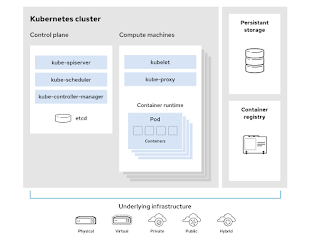A working Kubernetes deployment is called a cluster. You can visualize a Kubernetes cluster as two parts: the control plane and the compute machines, or nodes.
Each node is its own Linux® environment, and could be either a physical or virtual machine. Each node runs pods, which are made up of containers.
The control plane is responsible for maintaining the desired state of the cluster, such as which applications are running and which container images they use. Compute machines actually run the applications and workloads.
Kubernetes runs on top of an operating system (Red Hat® Enterprise Linux®, for example) and interacts with pods of containers running on the nodes.
The Kubernetes control plane takes the commands from an administrator (or DevOps team) and relays those instructions to the compute machines.
This handoff works with a multitude of services to automatically decide which node is best suited for the task. It then allocates resources and assigns the pods in that node to fulfill the requested work.
The desired state of a Kubernetes cluster defines which applications or other workloads should be running, along with which images they use, which resources should be made available to them, and other such configuration details.
From an infrastructure point of view, there is little change to how you manage containers. Your control over containers just happens at a higher level, giving you better control without the need to micromanage each separate container or node.
Your work involves configuring Kubernetes and defining nodes, pods, and the containers within them. Kubernetes handles orchestrating the containers.
Where you run Kubernetes is up to you. This can be on bare metal servers, virtual machines, public cloud providers, private clouds, and hybrid cloud environments. One of Kubernetes’ key advantages is it works on many different kinds of infrastructure.













.gif)
0 Comments